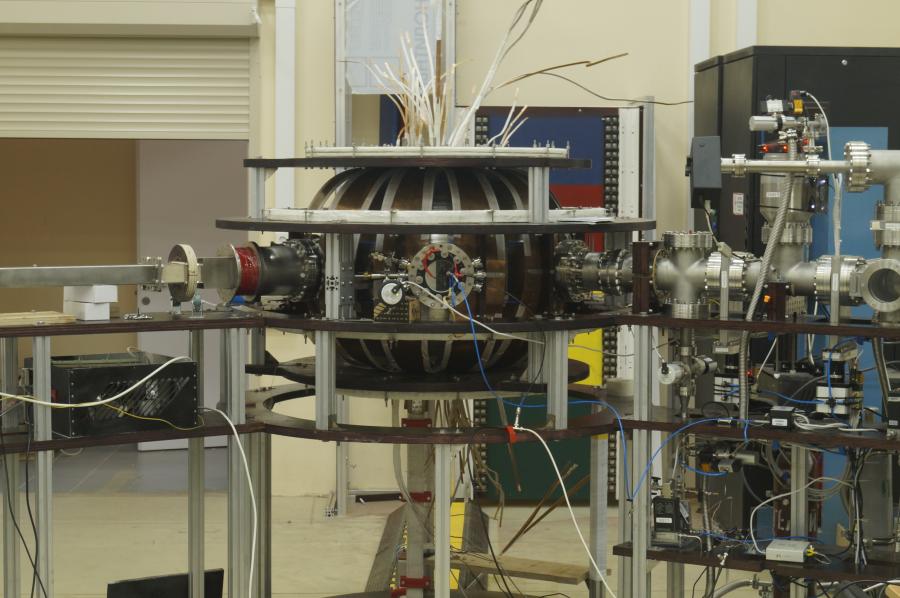For the first time, MEPhI researchers have studied the accumulation of helium and deuterium in promising "smart" W-Cr-Y alloys. In their opinion, this will help to select alloys for use in thermonuclear reactors. The results of the study were published in the highly rated journal Journal of Nuclear Materials .

Training and demonstration tokamak "MEPhIST-0"
The interaction of plasma with the inner wall of a thermonuclear reactor remains one of the key problems for obtaining thermonuclear energy, said Zori Harutyunyan, Junior Researcher at the Department of Plasma Physics at MEPhI.
“The fact is that the material of the inner wall of the reactor will be exposed to intense flows of particles of isotopes of hydrogen, helium and neutrons. This will lead to changes in the operational characteristics of the material and reduce the life of the reactor,” he said.
According to him, today tungsten is considered the best material for the inner walls of a thermonuclear reactor, due to its physical properties, such as high melting point and thermal conductivity, low sputtering under the action of plasma.
In future fusion power plants, operational safety will be of paramount importance. However, one of the potential problems of using pure tungsten as a material for the inner wall of the reactor may be the formation of volatile tungsten oxide and its release into the environment in emergency situations.
“According to calculations made for the DEMO reactor, under conditions of an accident with loss of coolant and air penetration, the rate of sublimation of tungsten oxide into the atmosphere can reach several hundred kg/h from a surface area of 1000 m2. Such active evaporation of material and radioactive release during accidents must be minimized. Therefore, it is necessary to consider other materials of the inner wall of a thermonuclear reactor, in addition to pure tungsten,” explained Zori Harutyunyan.
Today, scientists from different countries are developing new alloys based on tungsten with improved properties. Stable oxide-forming light elements such as chromium, titanium, yttrium, and silicon are added to tungsten. During normal operation of a fusion reactor, the plasma sputters out the added light elements, leaving a nearly bare tungsten surface. In an accident, when the temperature of the inner wall rises, the added elements to the tungsten enrich the surface and, in the presence of oxygen, create their own oxide layer on the surface, which protects the tungsten from further oxidation and sublimation. Thanks to this concept of work, innovative alloys are called "smart" alloys.
For the first time, MEPhI scientists have studied the accumulation of helium and deuterium in promising "smart" W-Cr-Y alloys. This, in their opinion, will help determine the suitability of these alloys for use in fusion reactors.
“Using thermal desorption spectroscopy, we studied how deuterium accumulates in the W-11.4Cr-0.6Y and W-10Cr-0.5Y alloys obtained, respectively, by spark plasma sintering and hot isostatic pressing, as well as in pure tungsten. The accumulation was carried out by introducing deuterium ions into the material at an ion-beam facility at temperatures expected on the inner wall of the DEMO reactor under stationary plasma operation conditions,” said Zori Harutyunyan.
The scientists also studied the accumulation of deuterium in alloy samples with the successive introduction of helium and deuterium ions. They were able to detect an increased accumulation of deuterium in W-Cr-Y alloys compared to pure tungsten, with more deuterium accumulating in W-11.4Cr-0.6Y than in W-10Cr-0.5Y. The general dynamics of the influence of helium on the accumulation of deuterium in W-Cr-Y alloys did not differ much from pure tungsten.
“The results obtained can be used in assessing the accumulation of hydrogen isotopes, in particular, radioactive tritium, the accumulation of which in the reactor walls must be controlled for safety reasons. Also, these data can be used to determine the operating modes of thermonuclear installations using "smart" W-Cr-Y alloys as the material of the inner wall of the reactor," the scientist concluded.





